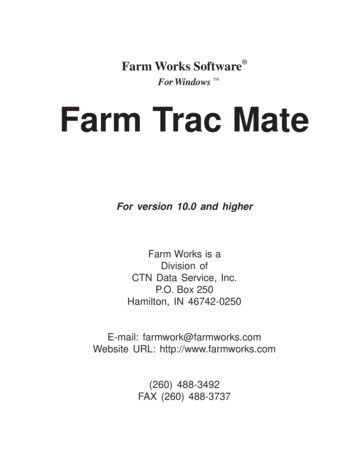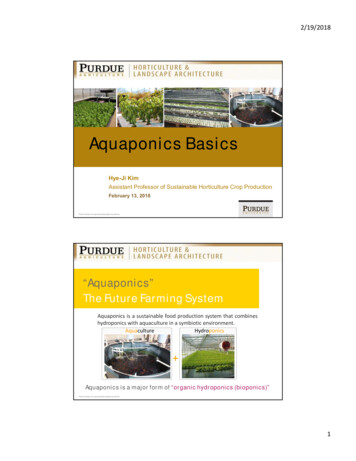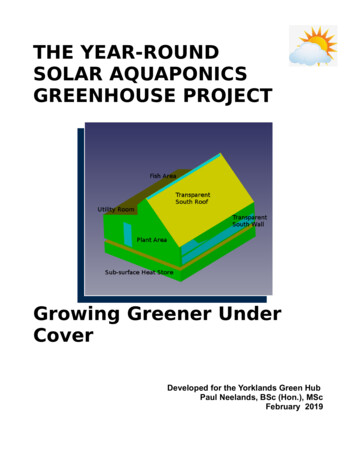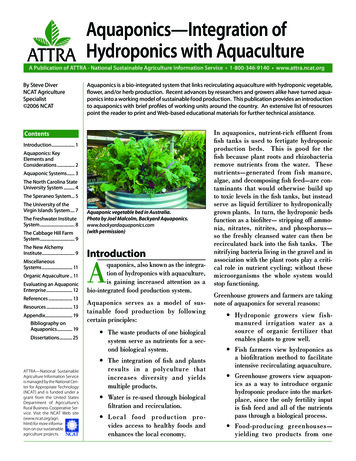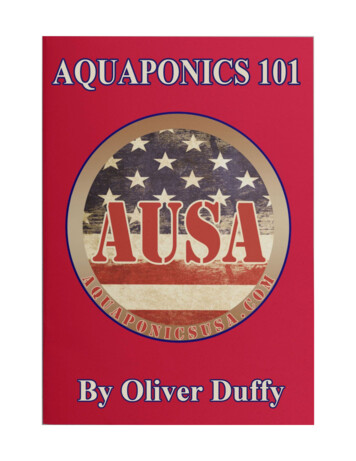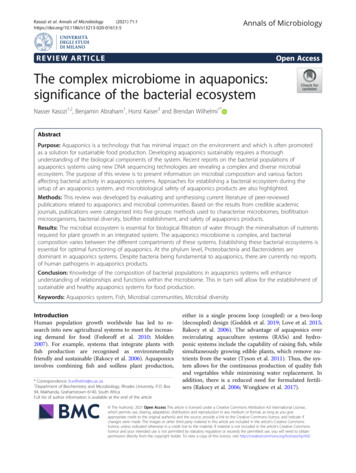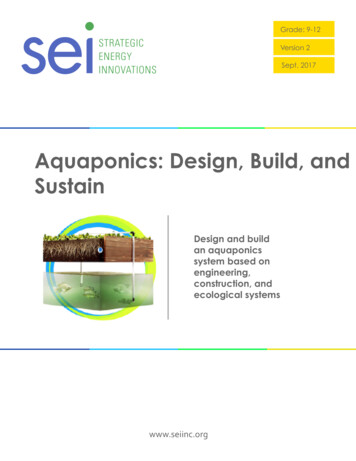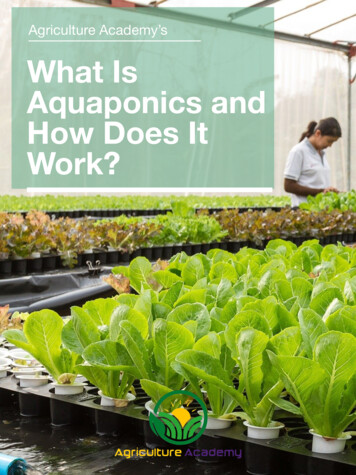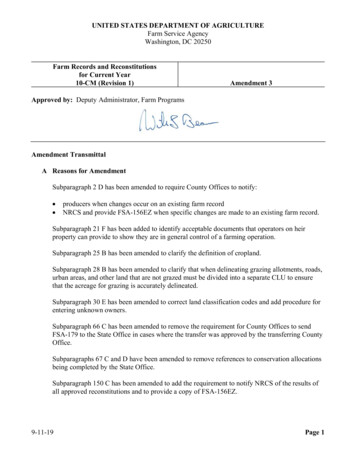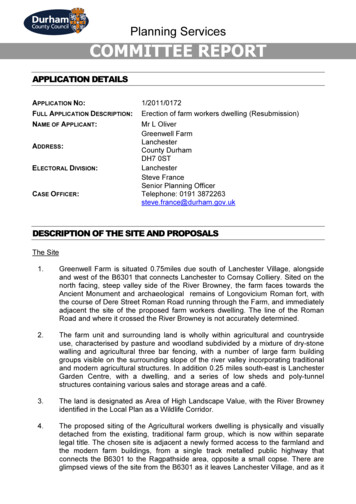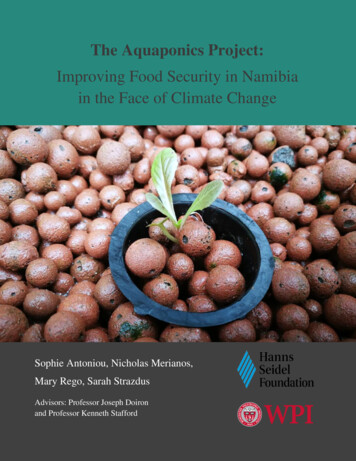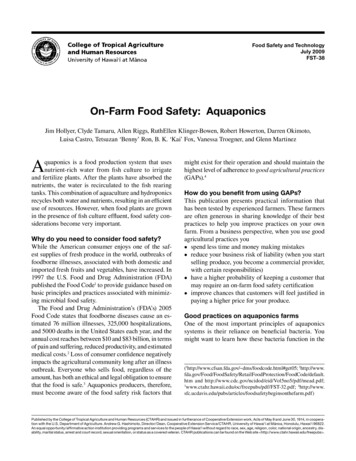
Transcription
Food Safety and TechnologyJuly 2009FST-38On-Farm Food Safety: AquaponicsJim Hollyer, Clyde Tamaru, Allen Riggs, RuthEllen Klinger-Bowen, Robert Howerton, Darren Okimoto,Luisa Castro, Tetsuzan ‘Benny’ Ron, B. K. ‘Kai’ Fox, Vanessa Troegner, and Glenn MartinezAquaponics is a food production system that usesnutrient-rich water from fish culture to irrigateand fertilize plants. After the plants have absorbed thenutrients, the water is recirculated to the fish rearingtanks. This combination of aquaculture and hydroponicsrecycles both water and nutrients, resulting in an efficientuse of resources. However, when food plants are grownin the presence of fish culture effluent, food safety con siderations become very important.Why do you need to consider food safety?While the American consumer enjoys one of the saf est supplies of fresh produce in the world, outbreaks offoodborne illnesses, associated with both domestic andimported fresh fruits and vegetables, have increased. In1997 the U.S. Food and Drug Administration (FDA)published the Food Code1 to provide guidance based onbasic principles and practices associated with minimiz ing microbial food safety.The Food and Drug Administration’s (FDA’s) 2005Food Code states that foodborne diseases cause an es timated 76 million illnesses, 325,000 hospitalizations,and 5000 deaths in the United States each year, and theannual cost reaches between 10 and 83 billion, in termsof pain and suffering, reduced productivity, and estimatedmedical costs.2 Loss of consumer confidence negativelyimpacts the agricultural community long after an illnessoutbreak. Everyone who sells food, regardless of theamount, has both an ethical and legal obligation to ensurethat the food is safe.3 Aquaponics producers, therefore,must become aware of the food safety risk factors thatmight exist for their operation and should maintain thehighest level of adherence to good agricultural practices(GAPs).4How do you benefit from using GAPs?This publication presents practical information thathas been tested by experienced farmers. These farmersare often generous in sharing knowledge of their bestpractices to help you improve practices on your ownfarm. From a business perspective, when you use goodagricultural practices you spend less time and money making mistakes reduce your business risk of liability (when you startselling produce, you become a commercial provider,with certain responsibilities) have a higher probability of keeping a customer thatmay require an on-farm food safety certification improve chances that customers will feel justified inpaying a higher price for your produce.Good practices on aquaponics farmsOne of the most important principles of aquaponicssystems is their reliance on beneficial bacteria. Youmight want to learn how these bacteria function in the(1http://www.cfsan.fda.gov/ dms/foodcode.html#get05; ection/FoodCode/default.htm and ;3www.ctahr.hawaii.edu/oc/freepubs/pdf/FST-32.pdf; tybeginsonthefarm.pdf)Published by the College of Tropical Agriculture and Human Resources (CTAHR) and issued in furtherance of Cooperative Extension work, Acts of May 8 and June 30, 1914, in cooperation with the U.S. Department of Agriculture. Andrew G. Hashimoto, Director/Dean, Cooperative Extension Service/CTAHR, University of Hawai‘i at Mānoa, Honolulu, Hawai‘i 96822.An equal opportunity/affirmative action institution providing programs and services to the people of Hawai‘i without regard to race, sex, age, religion, color, national origin, ancestry, disability, marital status, arrest and court record, sexual orientation, or status as a covered veteran. CTAHR publications can be found on the Web site http://www.ctahr.hawaii.edu/freepubs .
UH–CTAHROn-Farm Food Safety: AquaponicsFST-38 — July 2009conversion of ammonia to nitrate via the nitrogen cycle.5Unfortunately, the mention of “bacteria” often conjures upthoughts of “germs,” so we need to distinguish betweenhelpful microbes and the pathogens that can harm us. Bothin nature and in aquaculture, fish excrete ammonia fromtheir gills as part of their waste-elimination metabolism.The ammonia is then converted into nitrite and then tonitrate by beneficial bacteria (such as Nitrosomonas andNitrobacter species). When plant roots find nitrate in thesolution around their roots, it is taken up and convertedinto amino acids, the building blocks of proteins.In contrast to the beneficial bacteria that help turn fishwaste products into plant food, zoonoses are diseases ofanimals, caused by bacteria and other organisms, that canbe transmitted to humans. Zoonotic pathogens representa health risk to people contacting the water used in anaquaponic system6 or to people consuming food that haszoonotic pathogens on them. If the water you are usingcontains E. coli, salmonella, or other pathogens, you musttake immediate steps to address potential contaminationissues. You need to reduce or eliminate the risk of causinga foodborne illness in someone consuming your produce.By following some simple, basic sanitation procedures,you can significantly minimize this risk. Key areas ofconsideration include human sanitation harvesting produce safely managing warm-blooded animal feces water sources for fish and produce zoonoses prevention disposing of the system’s waste water.Human sanitationOne of the biggest risks to fresh produce safety is ourhands, which are in continual contact with the environ ment. When you harvest produce, be mindful of whatyou have touched before you touch the food product thatyou will sell or serve to others. Before harvesting yourplant crops, wash your hands using liquid soap, rinsethem for at least 20 seconds with potable water, and drythem with single-use paper towels. Wash hands everytime after using the bathroom, eating, smoking, pettinganimals, shaking hands with someone, changing diapers,handling fish, putting your hands into the system’s water,touching your head (mouth, nose, ears, hair), cycle/a/nitrogencycle.htm; 6http://www.cdc.gov/ncidod/dpd/animals.htm)2Wash your hands and all harvesting tools and equipmentwith soap in potable water.
UH–CTAHRGood HArvestinG tecHnique:W i t h was he d h a n d s , o r wa s h e dhands covered with clean disposablegloves, touch only the produce whenharvesting.On-Farm Food Safety: AquaponicsDO NOT touch the raft or the waterunderneath the raft during harvesting.That contaminates your hands orgloves with bacteria, which can thencontaminate the produce.Harvesting produce safelyYou need to keep harvest bins, cutting utensils, producecontact surfaces, and your hands clean, because you touchproduce that someone might not wash before putting itinto their mouth. The basics of good on-farm food safetypractices require a toilet within 1 4 mile or five minutes walk of theoperationa sink with potable water, single-use towels, pumphand soap, and a covered trash can a first aid kit prohibiting smoking, chewing, or eating around theproduction or packing areas sanitizing all harvest tools and bins before each har vest, and keeping all harvest containers off the soilsurface removing all pest-attracting trash from the farm andsetting up a pest control system periodically testing fish and produce rinse water forhuman pathogens removing nests of birds or animals and excludinglivestock and pets from production and packing areas FST-38 — July 2009For the same reason, DON’T touchthe root system or growing cup whenharvesting.covering all packing materials so that they don’t getcontaminated by insect or rodent droppingshaving an appropriate and well maintained refrigerator(if required)not harvesting produce that has fecal material or pestdamage, because of the possibility that pathogens areleft on the producerinsing produce only in potable water (never aquaponicsystem water or other irrigation water)not cutting produce into a salad mix or other seem ingly “read-to-eat” product for sale (of any amount)unless your facility has been approved by the Hawai‘iDepartment of Healthlabeling all your produce bags with your farm name,address, phone number, the product name, date andlocation of harvest, and a statement advising consum ers to “rinse before eating or serving.”More information on best commercial produce handlingpractices can be found at htm.3
UH–CTAHROn-Farm Food Safety: Aquaponicsnets help keep this lettuce aquaponics system fromcontamination by pests and their feces. Photo: H. AkoManaging warm-blooded animal fecesIt is important to keep warm-blooded animals (birds,dogs, cats, rats, sheep, goats, ducks, cattle, pigs, etc.)away from your commercial produce, because they maycontain pathogens harmful to humans. Placing nettingover your produce operation will reduce animal-to-plantcontact. Keeping your production tanks off the groundwill also limit access by animals. Cull any plants soiledwith fecal droppings, such as from birds. After allharvested product has been safely removed, remove allcontaminated produce and dispose of it where it will notattract additional pests.Water sources for fish and produceAlthough there are no state or federal regulations aboutwater quality for fish production, it is a best practice tosource aquaponic production water only from potablesources (city or well water). Streams, reservoirs, androof-top rainwater catchment systems can have sig nificant quantities of zoonotic pathogens introducedby domesticated or wild animals (e.g., rats, cats andother pets, livestock, birds), and thus it is best to neveruse water from these sources in your food productionsystem. For example, salmonella carried by amphibianscan contaminate non-potable water used in aquaponicsproduction and wash waters. If catchment rainwater mustbe used, follow guidelines recommended for keeping thecatchment system free of contamination.7At present, there are no national or State of Hawai‘i4using only potable water foryour aquaponics system isa good start toward foodsafety.FST-38 — July 2009Take a water sample fromthe fish tank and have ittested for E. coli and otherhuman pathogens.An example of a laboratory report of an analysis of fishculture water from an aquaponics farm. A produce-safeaquaponics production system will have little or no E.coli bacteria in the system water. Typically, however, itwill have various quantities of coliforms, which are nota good indicator of a food safety risk in an aquaponicssystem. The counts of E. coli are obtained during the testfor total coliform, so both results are reported.standards for the quality of irrigation water for land based produce. Water quality standards for agricultureat this time are based on those set for recreational uses(any body of water where human activity occurs).Based on a statistically sufficient number of samples(generally not less than five samples equally spaced overa 30-day period), the geometric mean of the indicatedbacterial densities should not exceed one or the other ofthe following: E. coli 126 per 100 ml; enterococci 33 per100 RM-12.pdf; trept.pdf)
UH–CTAHROn-Farm Food Safety: Aquaponicsno(bare hands)Yes(protective gloves)Growing media, such as volcanic cinders, can be sharpand cause cuts that can get infected. it is wise to wearprotective, waterproof gloves when digging into themedia. This is especially important where youngstersare assisting.Wear protective gloves when handling fish.FST-38 — July 2009in your home kitchenTo really grasp the potential risks of diseases causedby food contamination, you can think of your aqua ponics farm as though it were your kitchen. This isgoing to be the case with many small-scale farmersthat grow and eat the food produced on their farm.As an aquaponics grower, you will be producing bothfish and produce, so you need to be aware of waysto reduce cross-contamination when you consumeyour products.(NOTE: This advice is for home kitchens and is notintended to promote commercial processing of fishor produce in the absence of a facility approved forthe purpose by the Hawai‘i Department of Health.)It is a best sanitary practice in any kitchen to haveseparate cutting boards for fresh produce and for meat.The following steps are recommended when bothproduce and meat (including fish) are on the menu: Wash cutting boards and knives with soap in hotwater before cutting produce. Rinse off all soapunder running water for at least 20 seconds anddry as necessary with a single-use paper towel.Cloth dishtowels, once used after laundering, canhold and spread pathogens. Pull apart produce as appropriate and rinse it inclean, cool water. Look very carefully for smallsnails and slugs that might be stuck deep down inthe plant. Throw away any product that has snails,slugs or their slime on it as it could have come incontact with the ratlungworm pathogen. Cut up the cleanedproduce as desired. As with vegetables,wash cutting boardsand knives with soapin hot water beforecutting meats. After use, wash and Separate produce fromdry the cutting boards meat in your kitchen.as described above. Store cutting boards and knives in a way thatanimals (e.g., cats, geckos, mice) and insects (e.g.,cockroaches, ants) cannot contact them.For more information on food safety in the kitchen, 5.pdf.5
UH–CTAHROn-Farm Food Safety: AquaponicsZoonoses preventionFish are cold-blooded animals whose body temperaturesare the same as the water in which they live. Humans arewarm-blooded mammals that expend energy to maintainan internal body temperature of 98.6 F regardless ofthe environmental temperature. This physiological dif ference is the main reason that cultured aquatic speciesare not considered high-probability vectors of zoonoticdiseases to humans. However, a few fish pathogens can beproblematic under certain circumstances. Most of theseare bacteria that infect humans through skin puncturesmade by fish spines during handling, or through openwounds exposed to contaminated water. Humans withhealthy immune systems rarely have serious or long term problems associated with a superficial puncture.However, immune-suppressed individuals should takeextra precautions to avoid possible exposure, and if oneoccurs, they should seek medical attention promptly.Whether you have a fish-only (aquaculture) operation oran aquaponic (fish and produce) production system, thefollowing basic preventive guidelines should be followedwhen touching the production water: Before handling fish or fish system water, cover openwounds to prevent exposure. Wear pierce-proof waterproof gloves, boots, waders,and other appropriate personal protective equipment. Wash hands with clean water and anti-microbial soap(or waterless hand cleaner) after contact with the sys tem water. Report sick fish to an aquatic animal health profes sional immediately so that disease management rec ommendations can be implemented.If an injury occurs while handling fish or working inthe system water, immediately wash the area with cleanwater and anti-microbial soap. A tetanus booster shotis recommended if you have been more than five yearswithout one. Watch for any of the five signs or symptomsof inflammation: heat, redness, swelling, pain or loss offunction, and fever or chills. Any indication of infectionrequires immediate medical attention to avoid furthertissue damage or systemic disease development.disposing of system waste waterIt is best to apply “used” fish effluent water to soil. Useit to irrigate and fertilize grassy areas, landscape plants,or crops such as papaya and banana. Do not put fish6FST-38 — July 2009tank water directly back into a stream, sewer, irrigationditch, or reservoir, because you might be releasing smallfish or other aquatic life forms into that stream or watersystem, and in so doing you will be violating the U.S.Clean Water Act and Hawai‘i State Regulation S4-71 6.5(g) relative to releasing exotic or non-native speciesinto the environment.SummaryGrowing fish and plants in an aquaponics system is anovel and attractive idea. Many people are doing it suc cessfully worldwide, using systems that may be ancientor may rely on the latest contemporary materials andtechnologies. Remember, however, that once you startselling fish or plant produce from an aquaponics system,you step into the realm of commercial responsibility,regardless of the amount of your sales. Follow the advicegiven above to reduce risks to your personal health andthe liability of your commercial operation.resources on aquaponicsAquaponics and food safety. Gordon A. Chalmers, DVM.Lethbridge, Alberta. April, 2004.The Backyard Aquaponics Magazine. Joel Malcolm.Western Australia. http://www.byapmagazine.com.Fish: A potential source of bacterial pathogens for hu man beings. L. Novotny, L. Dvorska, A. Lorencova,V. Beran, and I. Pavlik. Vet. Med. - Czech, 49, 2004(9): 343-358 www.vri.cz/docs/vetmed/49-9-343.pdf.National Sustainable Agriculture Information Service,http://attra.ncat.org.Recirculating aquaculture tank production systems:Aquaponics—Integrating fish and plant culture.James E. Rakocy, Michale P. Masser, and ThomasM. Losordo. Southern Regional Aquaculture Center.November 2006 revision. SRAC publication no. 454.Tilapia farms guidelines for BAP standards. GlobalAquaculture Alliance. 2009. http://www.aquacultu recertification.org/index.php?option com content&task view&id 105&Itemid 47.
UH–CTAHROn-Farm Food Safety: AquaponicsFollow-up contactsThe following resource persons are available to help youimprove your aquaponics production and food safetypractices.Aquaculture advisingClyde S. TamaruAquaculture Specialist, Dept. of Molecular Biosciencesand Bioengineering, College of Tropical Agriculture andHuman Resources (CTAHR), University of Hawai‘i atMānoa; 1955 East-West Road rm. 218, Honolulu, HI 96822808-342-1063; ctamaru@hawaii.eduRobert HowertonAquaculture Specialist, University of Hawai‘i Sea GrantCollege Program, Maui Community College310 Ka‘ahumanu Avenue, Kahului, HI 96732808-268-3246; howerton@hawaii.eduFST-38 — July 2009On-farm food safety coaching(Note: these contacts are subject to change.)Hawai‘i islandLuisa Castro, CTAHR Educational SpecialistHilo, Hawai‘i808-981-5199 x 250; luisac@hawaii.eduMaui countyLynn Nakamura-Tengan, CTAHR Extension EducatorKahului, Maui808-244-3242, ext 233; lynnnaka@hawaii.eduO‘ahu and Kaua‘iJim Hollyer, CTAHR/ADAP Program ManagerHonolulu, O‘ahu808-956-9539; hollyer@hawaii.eduO‘ahuAquatic animal healthAllen C. Riggs, DVM, MSVeterinary Medical Officer III, Aquaculture Develop ment Program, Hawai‘i Department of Agriculture1039 Sand Island Parkway, Honolulu, HI 96819808-832-5005; acriggs@hawaiiaquaculture.orgJari Sugano, CTAHR Extension AgentKāne‘ohe, O‘ahu808-247-0421; suganoj@ctahr.hawaii.eduSite inspections/permittingVernon K. NakamotoInvertebrate and Aquatic Biota Specialist, Plant Quar antine, Hawai‘i Department of Agriculture1849 A‘uiki Street, Honolulu, HI 96819808-832-0577; Vernon.K.Nakamoto@hawaii.govThe authorsOf the authors not identified on this page as follow-up contacts or CTAHR food-safety coaches, Vanessa Troegner iswith CTAHR’s Agricultural Development in the American Pacific Project; Tetsuzan ‘Benny’ Ron is the AquacultureProgram Coordinator, Office of the Vice Chancellor for Research and Graduate Education, University of Hawai‘i atMānoa; RuthEllen Klinger-Bowen is with the Aquaculture Development Program, Hawai‘i Department of Agriculture;Darren Okimoto is with the Sea Grant College Program, University of Hawai‘i at Mānoa; B. K. ‘Kai’ Fox is with theEducation Department of UH’s Hawai‘i Institute of Marine Biology; and Glenn Martinez is the proprietor of OlomanaGardens in Waimānalo, O‘ahu.AcknowledgmentsMahalo to Albert Louie, Robert Coffey, and Dr. James Rakocy for review and comment. Funding for the developmentof this publication came from the Hawai‘i Department of Agriculture and the Hawaii Farm Bureau Federation.7
aquaponic system. or to people consuming food that has zoonotic pathogens on them. If the water you are using contains E. coli, salmonella, or other pathogens, you must take immediate steps to address potential contamination issues. You need to reduce or eliminate the risk of causing a foodborne illness in someone consuming your produce.
